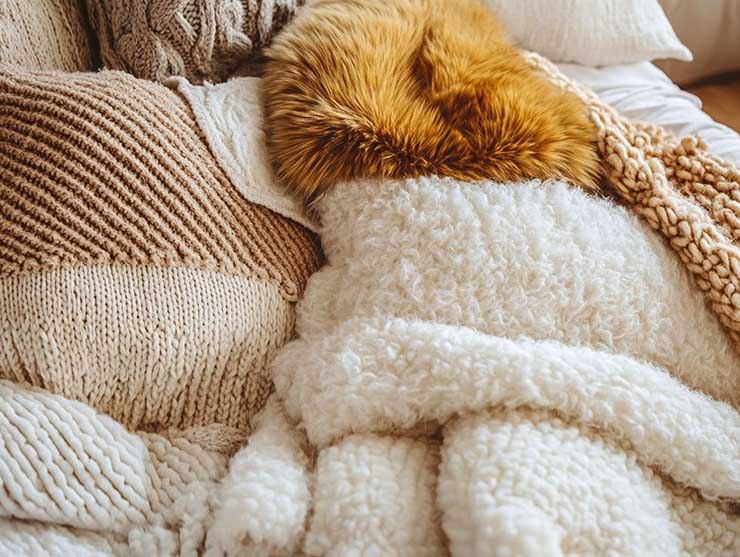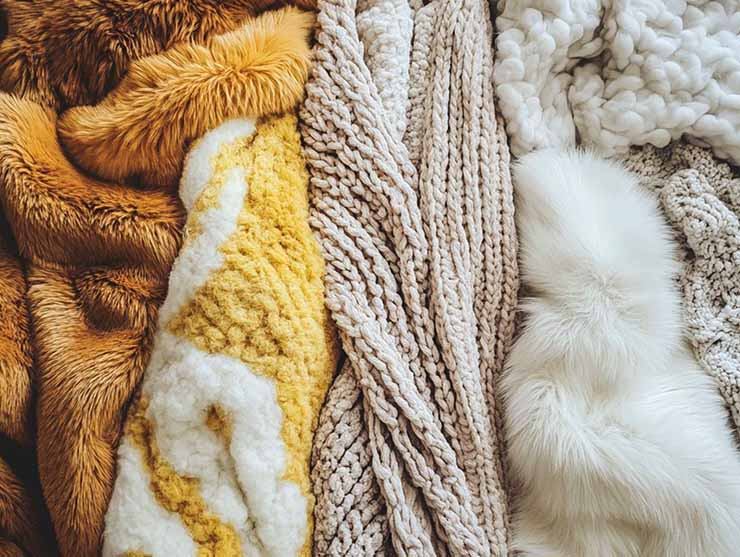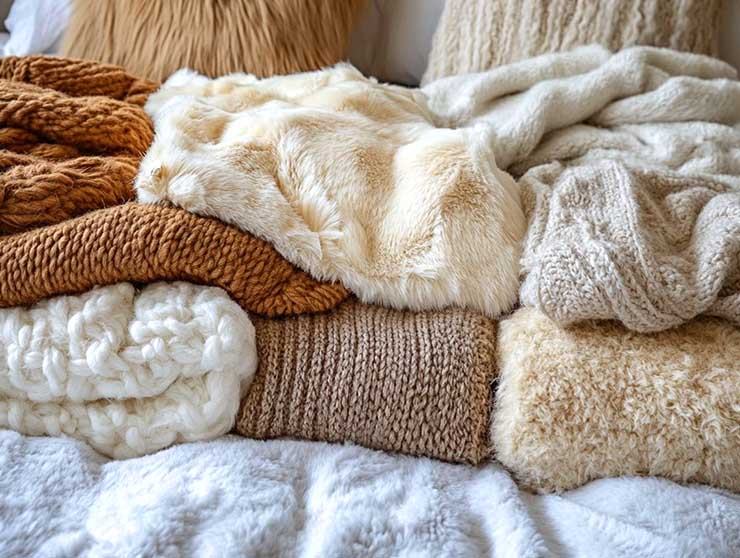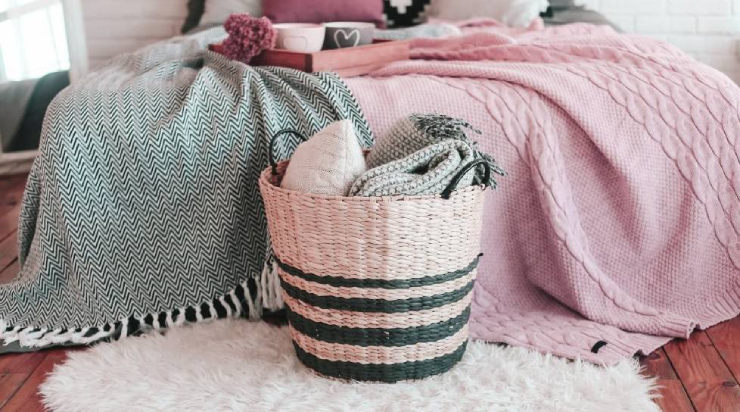Selecting the ideal blanket involves more than mere aesthetics – it encompasses factors such as comfort, warmth, and durability. Given the myriad of materials available, it is crucial to comprehend the characteristics that contribute to a quality blanket, thereby ensuring a restful night’s sleep.
This article examines the essential qualities to consider when choosing a blanket material, highlights the top ten cozy throw options, and provides guidance on selecting the most suitable one for your bedroom. Whether one favors the softness of cotton or the luxurious texture of cashmere, a variety of options are available to meet diverse preferences.
Key Takeaways:
- Choose a blanket material that is soft, durable, warm, breathable, and easy to maintain for ultimate comfort in your bedroom;
- The top 10 cozy throw blanket material types for bedroom comfort include cotton, wool, fleece, cashmere, acrylic, chenille, microfiber, flannel, sherpa, and minky;
- When choosing a blanket material, consider the material composition, weight and thickness, texture and feel, and care and maintenance to find the perfect fit for your personal preferences, climate, and purpose.
What Makes a Good Blanket Material?

Choosing a good blanket material is essential for creating a cozy home atmosphere, offering warmth and comfort while ensuring durability and easy maintenance. A quality blanket not only enhances your bedroom decor but also contributes to your overall well-being, making it an important investment in your comfort solutions.
From breathable fabrics like cotton and bamboo to luxurious options such as silk and cashmere, understanding the characteristics of various blanket materials can help you select the best throw blanket material tailored to your needs.
It’s also vital to consider factors such as weight, softness, and other blanket features that define the quality of your chosen blanket.
Softness
Softness is one of the most important attributes to consider when selecting a cozy blanket, as it directly impacts your comfort level while using it.
Choosing the right materials plays a crucial role in determining that coveted soft texture. For example, cotton is renowned for its breathability and natural fibers, making it gentle against the skin, ideal for warmer seasons. In contrast, fleece offers a plush feel that excels in insulation, perfect for cold nights.
Bamboo, on the other hand, not only provides softness but also boasts moisture-wicking properties, enhancing comfort further by regulating temperature.
- Cotton – Lightweight and breathable, perfect for warmer climates;
- Fleece – Thick and warm, excellent for chilly evenings;
- Bamboo – Soft, hypoallergenic, and moisture-wicking.
Each material invites its own unique experience, elevating relaxation and coziness while wrapped in your favorite blanket.
Durability
Durability is a critical factor to consider when evaluating different blanket materials, as it determines how long the blanket will maintain its quality and performance while protecting against wear and tear over time.
Several elements play a role in the fabric’s longevity, starting with fiber quality. High-quality fibers, such as cotton or advanced synthetic materials, contribute significantly to durability. They can withstand frequent washes without losing their softness or color.
The construction method affects how well a blanket holds up under regular use. For instance, tightly woven fabrics are more resistant to fraying and stretching, making them a better choice for long-lasting products.
To extend the longevity of various types of blankets, consider the following care tips:
- Wash blankets in cold water to prevent shrinking and fading;
- Avoid bleach, which can weaken fibers over time;
- Store blankets in a cool, dry place to prevent mildew and pest damage;
- Rotate use between multiple blankets to distribute wear evenly.
By paying attention to these factors, one can ensure that their investments in cozy comfort will last for years to come.
Warmth
Warmth is an essential quality of a good blanket, ensuring that it provides the necessary insulation during colder seasons while still being comfortable.
In the pursuit of the ideal blanket, different materials can make a significant difference. For instance, fleece is well-known for its lightweight yet thermally efficient properties, creating a soft embrace that retains heat without adding bulk.
On the other hand, wool is praised for its natural temperature-regulating abilities, allowing for breathability while still maintaining warmth. This makes it an excellent choice for those seeking versatility in their bedding options.
- Fleece offers a plush feel and is easy to care for;
- Wool is durable and has moisture-wicking properties.
The blend of these qualities not only enhances comfort but also elevates the blanket’s overall appeal, making it an essential addition to any home.
Breathability
Breathability plays a crucial role in ensuring comfort, especially in warmer climates, as it allows air circulation and prevents overheating, creating an ideal environment for both casual wear and active pursuits.
Different materials exhibit varying degrees of breathability, which can significantly impact the wearer’s experience throughout the year. Breathable options like cotton, for instance, are favored for their natural fibers that facilitate airflow and wick moisture away from the skin.
They are an excellent choice for hot summer days when staying cool is paramount. On the other hand, bamboo fabric provides a unique blend of comfort and sustainability, possessing remarkable moisture-wicking properties that keep the body dry and fresh. This makes it particularly suitable for humid environments.
In contrast, synthetic fabrics, while often praised for their durability, can sometimes trap heat against the skin unless designed specifically for breathability. This is important for users who might engage in outdoor activities during transitional seasons, requiring effective temperature regulation.
- For summer – Cotton and bamboo are preferred materials;
- For humid conditions – Bamboo excels in moisture control;
- For active wear – Specialized synthetic options can be advantageous.
Easy Maintenance
Easy maintenance is a significant consideration when choosing a blanket material, as it ensures that your cozy blanket remains hygienic and fresh without requiring extensive care.
Carefully selecting machine washable fabrics can greatly enhance the longevity and usability of any blanket, making it a practical choice for individuals and families alike.
Easy-care materials not only promote cleanliness but also fit seamlessly into busy lifestyles, allowing for quick cleaning routines that don’t sacrifice warmth or comfort. Thus, when engaging with different fabrics, it’s recommended to look for options like:
- Polyester;
- Cotton blends;
- Microfiber;
- Fleece.
These maintain their texture and color over time, providing a reliable solution for those who prioritize both comfort and convenience. Understanding the benefits of these versatile materials will significantly enhance the overall user experience.
The Top 10 Cozy Throw Blanket Material Types for Bedroom Comfort

In terms of creating a cozy bedroom environment, the choice of blanket material can significantly impact your comfort and overall aesthetic. The top 10 cozy throw blanket material types vary in texture, warmth, and maintenance, allowing you to select the perfect match for your personal style and bedroom decor.
Each material offers unique benefits, from the luxurious feel of cashmere to the affordability of polyester, ensuring you can find high-quality blankets that fit your budget and preferences. Understanding these material types will help you make informed blanket recommendations that enhance your bedroom comfort and style.
Cotton
Cotton is among the most popular and versatile blanket materials, known for its breathable properties and soft texture, making it ideal for year-round use.
In fact, many prefer cotton blankets because they regulate temperature effectively, allowing users to stay cozy without overheating.
This natural fiber not only feels great against the skin but also offers a cloud-like comfort that synthetic materials often struggle to replicate. Unlike polyester or microfiber, which can trap heat and moisture, cotton blankets foster an airy environment, making them perfect for any season.
- Breathability – Optimal airflow helps maintain a comfortable body temperature;
- Comfort – Its softness provides a gentle touch, enhancing the overall sleeping experience;
- Ease of Maintenance – Cotton is machine washable, making care simple and convenient.
The combination of these features ensures that cotton blankets, including the popular cotton knit blanket, are a favorite choice, standing out in a crowded market of bedding options and bed accessories.
Wool
Wool blankets are celebrated for their exceptional warmth and luxurious feel, making them an excellent choice for colder climates. Not only do these blankets provide outstanding insulation, but they also feature remarkable temperature-regulating properties.
This means that even in fluctuating temperatures, wool efficiently maintains body heat while allowing moisture to escape, keeping users comfortable throughout the night.
The hypoallergenic nature of wool makes it an ideal choice for those with sensitive skin or allergies, as it naturally resists dust mites and mold.
- Perfect for snuggling up on chilly evenings;
- Great for cozying up by the fireplace;
- Ideal in camping scenarios for added warmth and comfort;
- Beneficial as a decorative piece that also provides warmth in living spaces.
Integrating wool blankets into daily life not only enhances comfort but also supports better health and well-being. Their temperature-regulating material is ideal for maintaining comfort throughout the year.
Fleece
Fleece blankets are known for their incredibly soft texture and warmth, making them a popular choice for those seeking comfort at an affordable price.
These versatile blankets not only provide an unparalleled coziness but also come in a variety of colors and patterns, catering to individual tastes and home decor styles. Their lightweight nature adds to their charm, making them easy to transport and perfect for on-the-go warmth, whether for a picnic, campout, or cozy movie night at home.
- Fleece is typically less expensive than many natural fabrics, making it an economical choice for families;
- The maintenance of fleece is straightforward; it is machine washable and dries quickly, often requiring no ironing;
- In contrast, other materials like wool or cashmere can be more costly and require special care to maintain their luxurious feel.
In terms of achieving both affordability and comfort, opting for fleece is a decision that many individuals find rewarding.
Cashmere
Cashmere blankets embody luxury bedding, offering an unmatched softness and warmth that elevates any sleeping environment.
As they transform bedrooms into serene retreats, blankets made from this exquisite fiber provide both comfort and elegance, making them a top choice for those seeking luxury throw options.
Not only do they keep you cozy during chilly nights, but they also lend an air of sophistication to any decor, embodying luxury bedding. Cashmere’s natural properties help regulate temperature, ensuring that users remain snug without overheating.
- Perfect for those chilly winter evenings;
- Ideal for snuggling up with a good book;
- Simply delightful when draped over a stylish sofa.
It’s essential to consider proper care to maintain their divine softness and longevity. Gentle hand-washing or dry cleaning is recommended to preserve the integrity of this luxurious material.
Acrylic
Acrylic is a versatile and affordable blanket material known for its lightweight properties, making it an ideal choice for those seeking versatile blankets for use across various seasons.
This adaptability enables individuals to enjoy the comfort of an acrylic blanket during chilly winter nights as well as warmer summer evenings.
Unlike heavier materials like wool or cotton, which can be cumbersome and difficult to manage, acrylic blankets provide warmth without the bulk, allowing for easy storage and transport.
Their affordability makes it possible for anyone to enhance their home decor or travel essentials without breaking the bank. This is why they are considered one of the best materials for throw blanket choices.
In comparing acrylic with heavier alternatives, such as wool or alpaca wool, it becomes clear that the former offers significant advantages in terms of ease of care and longevity, as it tends to resist fading and staining more effectively.
Chenille
 Chenille blankets are recognized for their plush, soft texture that adds decorative accents to any bedroom while providing ample warmth.
Chenille blankets are recognized for their plush, soft texture that adds decorative accents to any bedroom while providing ample warmth.
The unique construction of chenille not only enhances its aesthetic appeal, making it an eye-catching addition to modern and traditional settings alike, but also invites a sense of comfort that wraps you in coziness during chilly nights.
Homeowners often find that these blankets complement various decor styles, from minimalist to bohemian, thanks to their rich colors and textures. The multiple colors available allow for a personalized touch in any setting.
- To maintain the beauty of chenille, gentle washing in cold water is recommended;
- Avoid harsh detergents and opt for a mild soap to preserve its softness;
- Air drying is preferable to keep it looking fresh and prevent shrinkage.
By following these simple maintenance tips, both the aesthetic and the comfort level can be enjoyed for years to come.
Microfiber
Microfiber blankets are favored for their soft feel and machine washable convenience, making them practical for everyday comfort solutions, whether as part of home decor or as cozy accessories.
Beyond their luxurious touch, these blankets offer remarkable durability and resilience, ensuring they withstand the wear and tear of daily life. This makes them one of the best blankets for enduring quality.
Families particularly appreciate how easily they can switch between cozy movie nights and spontaneous picnics without worrying about spills or stains – a testament to their low-maintenance nature.
The lightweight fabric does not trap heat, making it suitable for year-round use, whether snuggling on the couch during winter or lounging in warm weather.
With microfiber, the perfect blend of comfort and practicality is at one’s fingertips, enhancing any household’s comfort quotient and offering a cooling blanket option for warm weather.
Flannel
Flannel blankets are cherished for their warmth and soft texture, making them a cozy addition to any bedding set during the colder months. They are a great choice for those looking for seasonal blankets that provide softness and warmth.
These luxurious textiles, often crafted from cotton or a cotton-blend, provide unparalleled comfort that appeals to a wide range of individuals, from families seeking warmth during chilly nights to college students wanting a snug layer in their dorm rooms.
The versatility of flannel makes it a favored choice among various demographics, including:
- Families looking for durable, easy-care fabrics for everyday use;
- Outdoor enthusiasts who appreciate the insulation it offers when camping or during cold-weather activities;
- Individuals seeking a lightweight yet warm option to enhance their sleep experience.
In addition, the various colors and patterns available allow for a personalized touch, making them not just functional but also stylish elements in home decor.
Sherpa
Sherpa blankets offer a soft texture and exceptional warmth, often featured as decorative accents in contemporary bedroom decor.
Along with their undeniable coziness, these luxurious textiles excel in offering a plush feel that enhances comfort during colder months.
Unlike traditional fleece or wool, which may not provide the same level of gentleness against the skin, Sherpa blankets bring a unique versatility to the aesthetic of any space.
- They can effortlessly complement various styles, from rustic to modern;
- Their ability to drape elegantly over furniture adds a touch of sophistication, making them a staple in stylish design;
- Plus, the rich texture invites layering, making them an ideal choice for creating a welcoming atmosphere.
When searching for that perfect combination of warmth and design adaptability, the choice is clear – nothing rivals the softness and charm of Sherpa blankets.
Minky
Minky blankets are known for their ultra-soft texture and versatility, providing comfort as a cozy blanket for all ages.
These luxurious pieces are not only perfect for wrapping around infants during nap time, but they also serve as stylish additions to adult living spaces. Softness is a key feature that draws many to choose minky over other fabrics, offering a plush experience that invites snuggling.
- Lightweight properties make them easy to carry around, ensuring warmth without the bulk;
- Available in a range of colors and patterns, they cater to different tastes and preferences;
- Both children and adults can enjoy the enveloping comfort of minky, making them a favorite for family movie nights or chilly evenings.
As a result, minky blankets seamlessly blend functionality with elegance, making them a treasured item in any home.
What Are the Differences Between These Blanket Material Types
Understanding the differences between blanket material types is crucial for making an informed decision when selecting the best throw blanket for your home decor and comfort needs. Each material offers unique characteristics that affect its performance, aesthetic, and maintenance requirements.
From the material composition to the weight and thickness, these factors contribute to the overall experience and suitability of the blanket for varied seasonal conditions. Recognizing the texture and feel of different fabrics can help you choose a cozy accessory that aligns with your personal preferences and enhances your overall comfort solutions.
Material Composition

Material composition reveals the fundamental characteristics of each blanket type, influencing its performance, texture, and comfort level. Understanding these materials and their various fabric types allows consumers to choose blankets that align with their personal preferences and needs, ultimately enhancing their overall sleeping experience.
In terms of blanket materials, the choice can significantly impact warmth, breathability, and softness. For instance, cotton blankets are highly regarded for their natural breathability, making them perfect for warmer climates or for layering during cooler months.
Their hypoallergenic properties also make them a preferred option for those with allergies. Additionally, the use of organic cotton throw blankets offers an eco-friendly choice for environmentally conscious consumers.
- Wool blankets, on the other hand, excel in insulation, providing warmth even in cold conditions. They possess natural moisture-wicking properties that help regulate body temperature, ensuring comfort throughout the night. This makes wool one of the best materials for throw blankets aimed at providing maximum warmth.
- Lastly, fleece is a synthetic option known for its exceptional softness and lightweight feel, making it an ideal choice for those seeking a cozy, easy-to-care-for blanket. Fleece throws and blankets offer the added benefit of being durable and compact in size, perfect for travel or small storage spaces.
Each of these materials offers unique benefits that cater to different preferences, ensuring that everyone can find a blanket that suits their lifestyle.
Weight, Thickness, and Sizes
The weight, thickness, and sizes of a blanket are essential factors that determine its suitability for different seasons and comfort preferences.
When selecting a blanket, understanding how various materials interact with temperature can greatly enhance the overall experience. This approach allows for optimal warmth and versatility. For instance, lighter fabrics such as cotton or microfiber excel in warmer months, providing breathability while still offering a cozy feel.
In contrast, those opting for heavier blankets made from wool or fleece will appreciate superior insulation during chilly conditions. Weighted throw blankets and Vellux options are particularly suitable for those seeking added warmth and a sense of security.
- Cotton – Ideal for warm climates due to its lightweight nature. Consider a cotton throw for a versatile and breathable option;
- Wool – Excellent for retaining heat, making it perfect for colder environments. Wool blankets are durable and provide excellent insulation;
- Fleece – Soft and warm, offering exceptional comfort while being lightweight. Fleece blankets come in various sizes and are easy to care for.
Understanding these elements, including the most comfortable blanket material and the ideal blanket sizes, can help users choose blankets that meet their specific needs, ensuring a satisfying and comfortable experience.
Texture and Feel
The texture and feel of a blanket significantly influence your comfort level and overall satisfaction when using it.
The experience of wrapping oneself in a blanket goes beyond mere warmth; it involves an intricate ballet of textures that evoke different sensations. For example, luxury bedding often boasts plush and velvety fabrics that cradle the body, providing a sense of indulgence and relaxation.
Alpaca wool throws and bamboo throw blankets offer unique textures that elevate this experience. In contrast, budget-friendly options may utilize smoother fabrics, which, while functional, often lack the rich feel that enhances emotional well-being.
Consider the following comparisons:
- Luxury Bedding – Rich textures, often more durable, and can enhance sleep quality;
- Budget Options – Typically smoother and lighter, convenient for everyday use but may not offer the same level of satisfaction.
Ultimately, the right texture can transform a mundane night’s sleep into a soothing retreat, fostering an essential connection between comfort and quality.
Care, Maintenance, and Quality Testing
Care and maintenance are crucial considerations when selecting a blanket material, as they determine how easily you can keep your blanket looking fresh and new. Engaging in proper blanket care ensures long-lasting quality.
Understanding the specific care instructions for each blanket type can significantly enhance your overall experience. For instance, machine washable options not only offer convenience but also help in maintaining cleanliness without much effort.
Below are some tips to help ensure the longevity of various blanket materials:
- Cotton – This material is generally machine washable on a gentle cycle, and tumble drying on low heat is advisable. Regular quality testing can help maintain the integrity of the cotton fibers;
- Wool – Dry cleaning is often recommended, although some wool blankets can be hand-washed in cold water. Wool blankets benefit from careful maintenance to avoid wear-and-tear;
- Fleece – Usually safe to machine wash, but avoid high heat when drying to prevent pilling. Fleece blankets are known for their durability and ease of care.
By adhering to these care instructions, users can effectively prolong the lifespan and curb the wear-and-tear associated with daily use.
Therefore, investing time in proper maintenance not only enhances appearance but also ensures that the blanket remains cozy and functional for years to come.
How to Choose the Right Blanket Material for Your Bedroom
Choosing the right blanket material for your bedroom is vital to ensuring comfort and satisfaction while enhancing your home decor. Evaluating your personal preferences, climate considerations, and the blanket’s purpose can guide you in making a wise choice.
Understanding various blanket types and their features will help you select a cozy accessory that aligns with your needs. Whether you need a duvet, quilt, or a specific type of throw blanket, understanding these options is crucial.
Additionally, considering your budget will allow you to find high-quality blankets that fit your price range without compromising on warmth and comfort.
Consider Your Personal Preferences
Your personal preferences play a significant role in selecting the ideal blanket material, as comfort and style choices can greatly influence your satisfaction and overall experience with your chosen textiles.
Understanding how texture, color, and design contribute to your cozy encounters allows for a thoughtful selection process, enhancing both your interior decor and your relaxation time.
When considering the best blanket for your needs, focus on the following aspects to maximize blanket versatility:
- Texture – The feel of the blanket should resonate with your senses. Whether you gravitate towards the plush softness of fleece, the elegant warmth of wool, the luxurious feel of alpaca wool, or the crispness of cotton, each texture offers unique benefits;
- Color – Choose colors that align with your personal aesthetic and the existing palette of your living space. Soft pastels exude calmness, while vibrant hues can energize a room;
- Design – Patterns and styles should complement your decor. From modern geometrics to classic florals, the design can enhance the overall vibe of your home. A well-chosen blanket design can also serve as an aesthetic centerpiece.
By aligning these preferences with functional aspects, such as durability and ease of upkeep, one can ensure that the chosen blanket is not only aesthetically pleasing but also practical for everyday use. Whether selecting a durable blanket for frequent use or a lightweight blanket for easy handling, these considerations will enhance your overall experience.
Consider the Climate
Considering the climate in which you live is crucial for making the right blanket choice, as different materials offer varying levels of warmth and breathability. Selecting the appropriate blanket not only enhances comfort but also improves sleep quality.
When choosing blankets, it is essential to think about the seasonal temperature fluctuations and your personal preferences. Blanket versatility and adaptability to different climates can significantly improve their functionality.
- For warmer climates, opt for lightweight or breathable materials such as cotton or linen. These fabrics promote airflow and help regulate body temperature, resulting in a more restful sleep;
- In contrast, during the colder months, heavier fabrics like fleece or wool are ideal as they provide significant insulation to keep you warm and cozy.
Ultimately, understanding the specific needs based on your local climate can lead to a more satisfying blanket experience. The right choice can also enhance the overall aesthetic and functionality of your bedroom or living space.
Consider the Purpose of the Blanket
The purpose of the blanket is another key factor to consider, as it dictates whether you need a cozy accessory for warmth or a lightweight option for decoration.
When selecting a blanket, understanding its intended use can greatly influence your material choices. For instance, if someone is looking for a blanket primarily to keep warm during the chilly winter nights, opting for a thick fleece or wool option might be the best route. On the other hand, those interested in decorative throws may prefer cotton or lightweight blends that add flair without overwhelming their existing décor. For those who want a balance of warmth and weight, weighted blankets provide a unique solution that combines functionality with comfort.
- For outdoor picnics, a durable and water-resistant fabric would be ideal. A compact size blanket can also be convenient for portability;
- Conversely, for bed accessories, softness and breathability should take precedence.
Ultimately, the functionality and aesthetic goals associated with the blanket will guide the decision-making process, ensuring that each choice complements its specific role in the environment it inhabits. By considering quality testing and blanket maintenance requirements, one can ensure long-lasting satisfaction.
Consider Your Budget
Considering your budget is essential when selecting the right blanket material, as it helps determine the quality and type of blankets available to you.
It is equally important to understand that investing a little more can lead to a much more satisfying experience in the long run. Budget considerations also play a role in selecting hypoallergenic materials, which may have varying costs.
To effectively balance quality and affordability, begin by researching various blanket materials and their benefits. For instance, cotton is often an excellent choice for those seeking softness and breathability, while microfiber offers durability at a lower price point. Exploring weighted blankets or organic cotton throw options can also provide insights into top blanket material types for cozy and comfortable bedrooms and help you choose the best materials for your needs
Here are some tips to help you navigate this decision:
- Set a realistic budget – Knowing how much you can afford will narrow your choices without compromising quality;
- Check reviews – Customers frequently share insights that can guide your selection process;
- Explore discounts – Look for sales or coupons, especially during seasonal changes, which can help you snag a high-quality blanket without overspending.
By following these steps, you can find high-quality blankets that fit your financial limitations while ensuring a worthwhile investment for your comfort. Check out our FAQ section below for more details.
Frequently Asked Questions

I love traveling and writing. I’ve lived in different places across the world – Thailand, Japan, Indonesia and Bulgaria – and also traveled to many countries in Europe, Asia and South America.
At last I decided that the US was the best place for me and returned to my hometown.
Now I’m enjoying my time in Columbus, Ohio and I’ve turned to a new page in my life – blogging.

